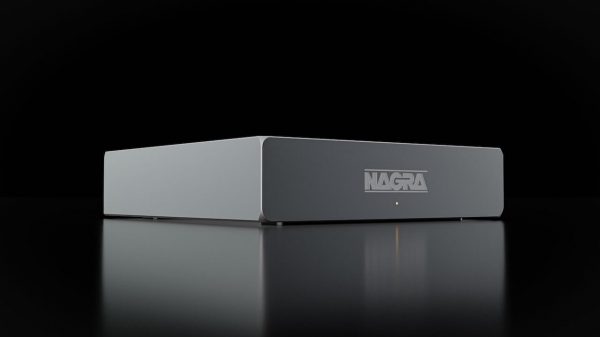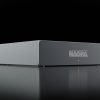This is the Huei.
Having spent the better part of my Saturday listening to the exceptional Chord Hugo 2, Qutest, Anni, and state-of-the-art DAVE, I realized that I left the Chord Huei out of the conversation. The Huei often gets ignored because so much attention is paid to the headphone amplifiers and DACs — but that’s a huge mistake on the part of the audio press.
Listening to the Chord Huei made me think about the cursory way we distinguish between vinyl and digital. Vinyl sounds warm, digital sounds cold. Vinyl sounds engaging, digital sounds fatiguing. Vinyl sounds organic, digital sounds hard. That’s audiophile wisdom for you. This is a generalization which is as ubiquitous as it is mistaken.
All things being equal I would say the Chord Qutest DAC ($2,125 / €1395) sounds smoother, warmer, more organic, than the Chord Huei phono stage ($1,775 / €1175). Likewise, I’d peck the Huei as sounding cleaner, more forward, and slightly hard on top. Going by the wisdom of yesteryear, the Huei sounds digital and the Qutest sounds analog. Slightly unexpected but ultimately true.

The Chord Huei is a standalone phono preamp with a wealth of possible settings. For someone who mostly uses the onboard phono stage that comes with whatever amp I am using at the time, the possibilities seem borderline excessive – but in a good way. For me, a crucial part of picking the right amplifier has previously been how good the onboard phono stage was. That requirement led me initially to Rega integrated amplifiers, before settling with the Croft Acoustics separates which are magnificent performers.
The way of the Huei
The Chord Huei looks like a Chord Qutest with a few additional buttons. That makes it an attractive piece of gear. It’s very functional and clean – and yet the signature glowing buttons sets it distinctly apart. There’s no question this is a Chord product. Having the Qutest and the Huei in your setup would be a minimalist’s. Like the Qutest, in the middle there’s a big see-through hole made of tempered glass where the innards are visible. Design where you remove something rather than add something makes sense to me. I feel the same way about those glowing buttons: they aren’t jewelry — they look cool because they are functional.

This is a small phono preamp. Each of its four buttons control a specific set of features. One is for switching between MC and MM. One is a Rumble Filter (very cool). There’s a button to set gain and there’s a button to select the Impedance. I used the MM setting with my Grado Labs Reference Master 1 cartridge and depending on the recording I set the gain at 30 or 32 dB. I only used the Grado cartridge, so I didn’t worry about setting the impedance. On the Chord Huei, that is limited to MC cartridges. The Rumble Filter was engaged the whole time as it lowered noise quite substantially on some records.

Why don’t I use MC cartridges? My feelings toward MC cartridges are sort of the same as towards hi-res music and DSD. I prefer a DAC where 16/44 is done right rather than some half-baked DSD implementation. Likewise, I think that if you’re on a tight(er) budget you get better sound with a good MM cartridge than with an equally priced MC. Also, I mainly use the onboard phono stage in various pre-amps and integrated amps, and often they don’t even do MC. Then I’m forced to also invest in a step-up transformer which means even more money that I think is better spent on an even better MM cartridge.
Nu? So what did I use?
My turntable is archaic. It’s designed and built by Hans Henrik Mørch. Aesthetics matter and it looks exactly the way I want it to. It was a gift from my parents. I’ll never sell it and have never contemplated upgrading it. My tonearm is also from Mørch; the UP-4 unipivot design. All together a clean and retro-looking setup that still sounds excellent.

I used two different headphone amps, the Cayin HA-1A MK2 ($999) and the Schiit Asgard 3 ($199). One tube, one solid state. Two amps with very different price points.
Headphones were my AudioQuest NightOwl Carbon and Sennheiser/Drop HD6XX. Why headphones? I enjoy listening to vinyl on speakers, but vinyl and headphones are an underrated combination. You get the intimacy of a good pair of headphones and you get to hear how quiet and aligned your vinyl rig really is. With headphones there is nowhere to hide. If something is off, you’ll know it.
Without comparisons, a review becomes meaningless. I’ve been more than a little impressed with the quality of the phono stage in my Croft Micro 25R pre-amp (£1400). I thought this was a good opportunity to see just how good it is. Surely, it can’t compete with the Chord Huei, a standalone phono preamp that retails for almost the same price of the Croft pre-amplifier.
Running with the Schiit Audio Asgard 3
I wasn’t really surprised that the solid state Schiit and a microprocessor-controlled phono preamp from a company that makes some of the best digital gear in the world, made for a clean sounding combination. Above I reflected on the differences between analog and digital. The Chord Huei and Asgard 3 produced the least ‘analog’ sounding vinyl playback I’ve yet encountered. Very clean, very quiet, and slightly cool.
The Danish band Lowly is difficult to categorize. Their album Hifalutin is, I suppose, (indie-)pop; it’s melancholic, profound, but also not too pretty, it’s acoustic and electronic, and the female vocals are strong and delicate. With the Asgard 3 and Huei those attributes are laid bare. It is detailed, and while there’s a minor hardness to the sound, it never becomes strident or sibilant. The bass is articulate and punchy.
I don’t care for this word, but maybe the sound of this combination is simply what people understand as neutral. I know this recording well and while I have all the detail and dynamics I could ask for, the Asgard 3 and the Huei leaves me a little cold. Sort of uninvolved.
That changes when I remove the Huei and plug in the Croft. Everything is smoother. Bass is not quite as distinct but there’s a mellowness in the midrange that does wonderful things – to vocals in particular. Any sibilance, if there was any, is gone. The sound is also fuller sounding here. With the Huei it is more glass-like. The Croft is warmer, smoother, but, interestingly, detail retrieval is about the same.
I get the impression that the Asgard 3, as good as it is, is holding both phono stages back. But with the Asgard 3 I prefer the Croft. The sound is rounder, richer and more engrossing.
I knew the Croft was good, but to edge out the stand-alone Chord Huei was unexpected.
With the Cayin HA-1A MKII
Death Machine, like Lowly, is a newish Danish band. Think folky melancholy acoustic-electronic singer-songwriter stuff. Or maybe Agnes Obel meets Ulver’s Kveldssanger, with a touch of Pink Floyd’s Meddle. It’s very atmospheric and dreamy and together with Lowly one of the most interesting Danish bands right now.

This time I start with the Croft. The Cayin and the Croft both use tubes and that readily becomes apparent. The Croft and the Cayin make Death Machine’s Cocoon album sound better than I’ve heard before. The acoustic guitar is spot on. Not dull, and with an edge that keep me engrossed. That innate quality of the Croft – which in my speaker system is its most important – of the right amount of detail balanced with a textural velvet smoothness and rich tonality is eminently translated by the Cayin and my HD6XXs. This pairing is delicate and rich.
Opening remarks aside, there is something right about vinyl, tubes, and headphones. It doesn’t necessarily sound better than hearing the same album through a comparatively priced digital setup. But it does sound different. It’s very intimate and tactile. There are textures here – some of which are probably distortions and surface noise – that I wouldn’t notice on my speakers. Textures that aren’t present when I listen to the same song via one of the DACs I have at my disposal. Does that make vinyl better than digital? Impossible to say, if nothing else, because the cost of my turntable, tonearm, cartridge, and phono stage is far greater than that of my digital components.
I think the Asgard 3 is a price-performance beast. But compared to the Cayin, with upgraded tubes, it falls short. Please remember that it’s about a fifth of the prize. Even though the Cayin instills some tube warmth and rolls of at the extremes, it is obvious that everything takes a step up. Particularly detail retrieval, ambience, tonality, texture, and – most important of all – my own engagement with the music. Cocoon is an album that is saturated with melancholy and the Croft/Cayin make this an emotionally charged listen.
The Chord Huei and the Magic of Tubes
Sometimes there’s a moment in the reviewing process where everything changes. That moment came when I fed the Huei some tubes. Sometimes you have to take a few steps backwards before you can take that huge leap forward.
When I connect the Huei to the Cayin, I feel that I have done the Chord a disservice. Now I hear what the Chord Huei is capable of. The Asgard held the Croft back — but it held back the Huei more. This is a seriously good pairing. It seems the Chord Huei really likes tubes. First, going back and forth between the Croft and Huei it is obvious that Death Machine’s Cocoon is a noisy record. Noise as in surface noise. The Rumble Filter alone makes a significant difference here. The result is still clean, but not cool as with the Asgard. I don’t feel removed from the music. I feel mesmerized.

The Huei is not as warm and smooth sounding as the Croft, which in this instance turns out to be a good thing. With the Cayin and the HD6XX, the Huei has extra bite. The bass is notably tighter and detail retrieval is improved. Now the Croft/Cayin lean too far toward syrupy. While the overall gestalt is still rich, the Huei takes everything closer to neutral.
There is more presence with the Huei. It is not just the Cocoon album that I heard this with. Electronic music is better served with the Huei because of its bass grip and detail retrieval. The Croft is no slouch, but in this regard the Huei reminds me of the Chord Qutest in that it really does bass well. I don’t have the Qutest in my system anymore, so take my aural memory with more than a grain of salt. If I remember correctly, however, the Qutest was fantastic in the low end. The Huei is the same. It’s the opposite of soft, but not hard. Rather, the bass is extended, clean and punchy like no phono stage, onboard or stand-alone, that I’ve heard in my system before. People spend a lot of money on their turntable to achieve this level of bass response, so color me impressed that a phono preamp like the Chord Huei can achieve such a result.

Conclusion
With the Schiit Asgard 3, I preferred the phono stage in the Croft. Impressive considering the price and the fact that the Croft Micro 25R is also a very good pre-amp. With the Cayin, I preferred the Chord Huei. It improved dramatically when I put it in front of better amplification. I found that it benefitted from a bit of tube warmth. With overly neutral solid-state amplification, it might be a bit too cool for my admittedly warm-leaning taste. I would go warm with loudspeakers in such a scenario; Wharfedale, Spendor Classic series, or Q Acoustics.
Going back to the theme of analog vs. digital; with the Huei and its Rumble filter engaged, I couldn’t tell if I was listening to analog or digital. I knew, of course, but this is a phono stage that is powerful, clean, punchy, and quiet. And a detail monster to boot. The adjustability which allows users to set gain and impedance-matching control makes this a supremely future-proof phono preamp regardless of which cartridge you might put in front of it. That’s longevity right there; and a wave goodbye to perceived obsolescence.
If that is what you’re looking for in vinyl playback, the Chord Huei is a good place to start. And, I think, a good place to stop. This just might be the last phono stage you’ll ever need or want.
Where to buy: $1,775 at AudioAdvice.com
Manufacturer product page: Chord Huei





































ORT
March 4, 2022 at 4:51 pm
“This is the Huei”…
Pardon me but I just HAD to comment upon your phraseology/play on words, if you will, with regard to this device as it is simply superb. This is what separates writing from the more common, “typing”. Talent born of a genuine sense of humor. Thanks!
The “typists” out there know who they are.
Scum, slime…Menace to the Audio Industry. You’re a disgrace and you’re typists. You’re one of the slowest members of the crude train and you’ll probably be replaced by low grade A.I.
To the author whose nom de plume is listed as “Contributor Articles”, I say, “HUZZAH!”
That is all. For now…
ORT
Ian White
March 4, 2022 at 6:36 pm
Guilty as charged for that one.
Ian White